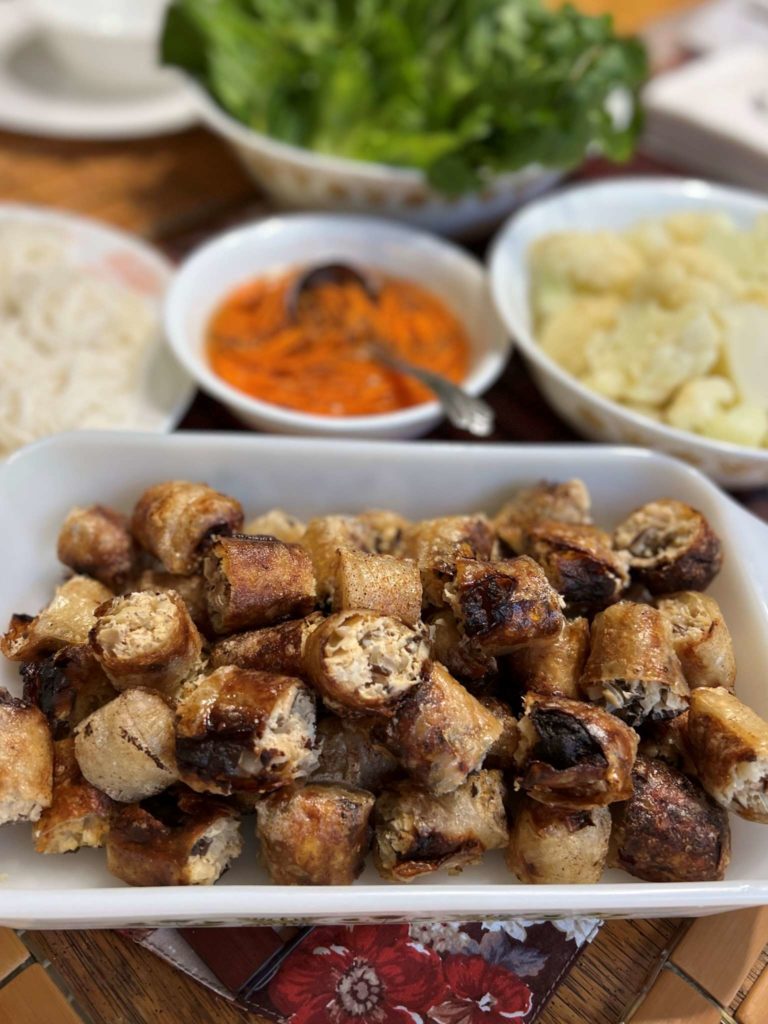
You may know these deep-fried rolls as imperial rolls, egg rolls, or spring rolls but to me, they simply go by their southern Viet name: chả giò. I don't know anyone who doesn't love the fried rolls wrapped in lettuce with herbs and maybe noodles -- all dunked in nước chấm dipping sauce. The rolls may feature pork and seafood, seafood, or be totally vegetarian. Trouble is, they are challenging to make. It's senior- to grad-level cooking.
When my dad was alive, he and my mom would make a big batch -- at least100 rolls, to serve our family at the holidays. Last year, when Bố Già's health was on a steep decline, one of my mom's cooking buddy was unavailable. She turned to me. We are friends in the kitchen and Vietnamese families like to keep chả giò in regular rotation. Mom and I experimented and fried several batches. I gained a lot from cooking with her. This post contains insights that she shared.
Before diving in, a couple of notes: Product changes and rice paper brand availability impact how your experience will be. Also, there's the filling. Everyone has a preference. I have a filling in Into the Vietnamese Kitchen, which reflects what our family enjoys: crab, shrimp, pork, wood ear mushrooms and glass noodles.
Best Rice Paper for Cha Gio
It used to be that the Red Rose brand was the best one for all Viet rice paper needs. Most Viet people purchased that brand and we recommended it to others, too. As you may have seen in this post, there are now many kinds of rice paper (bánh tráng) available. If you shop at a Little Saigon grocer, you'll likely have more choices than you ever thought possible.
"Choosing rice paper for chả giò is like playing roulette," my mom says. "You never know what will happen each time, with each package." She is into experimentation, which is why we tried several brands of rice paper purchased from Viet markets. I selected them for these reasons: (1) they are labeled for frying chả giò and/or (2) the ingredient listing puts rice first, before tapioca.
When shopping for the rice paper, study the package labeling. It helps that a photo of imperial rolls is part of the label. With the Double Parrot brand, the clue was rice listed first! Lots of sleuthing is involved in buying Viet rice paper but it's fun. Rice paper lasts years so lay in a supply before you embark on you chả giò journey. The brands below are not sold at mainstream supermarkets.
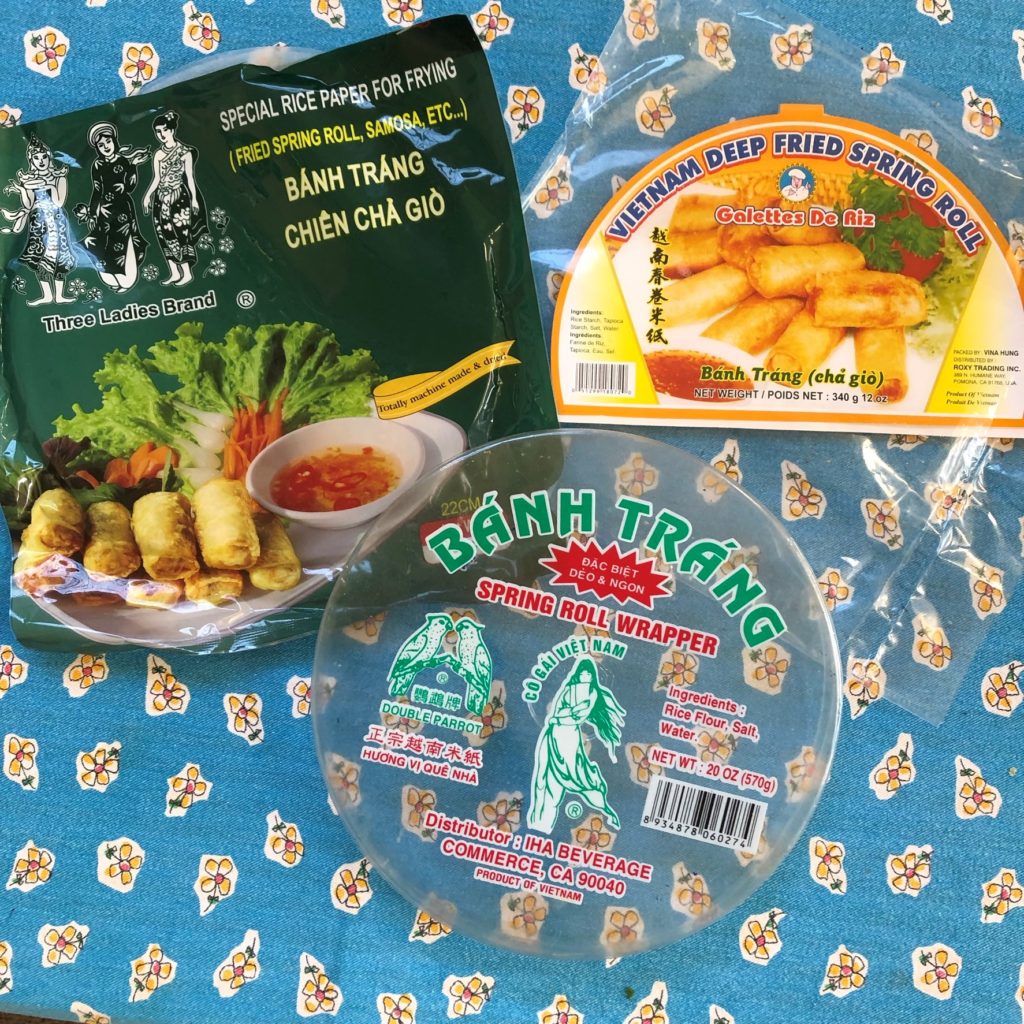
Why Not Use Egg Roll Wrappers for Cha Gio?
Egg roll wrappers are made of wheat and honestly, chả giò do not taste great wrapped in wheaty wrappers as they do when wrapped in rice-based papers. True egg roll wrappers are made of the same dough as wonton wrappers, but they are lots bigger. Egg roll wrappers, often sold nowadays in supermarket produce sections near tofu and wonton wrappers, are used for chubby Cantonese-style egg rolls.
What's mistaken for egg roll wrappers are actually Chinese spring roll or Filipino lumpia wrappers. They are wheat based and very thin; they are typically sold frozen at Chinese and Southeast Asian markets. Many Vietnamese cooks and restaurants wrap chả giò in those spring roll wrappers. They are easy to manipulate and quickly fry to a crisp. But, they just don't have the taste of true chả giò. Rice paper has a chew crispness and taste relatively light.
Low Moisture, Compact Filling
Vietnamese chả giò filling is raw. During the cooking process, moisture is released via steam and that can make the rice paper bust. To prevent that from happening, you want to minimize moisture in the filling. Partly rehydrated glass noodles go into the filling because they suck up moisture during cooking to take off some of the internal pressuring; the noodles are a filler and binder so they help to address moisture issues. I also pat moisture from wet ingredients such as seafood or vegetables.
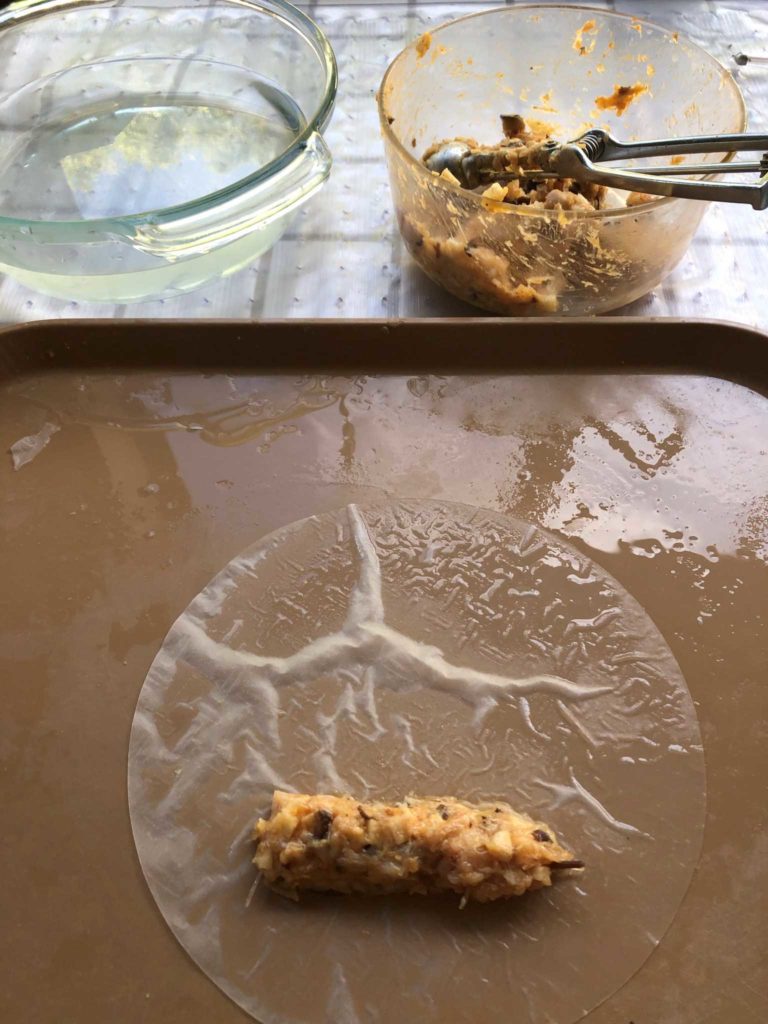
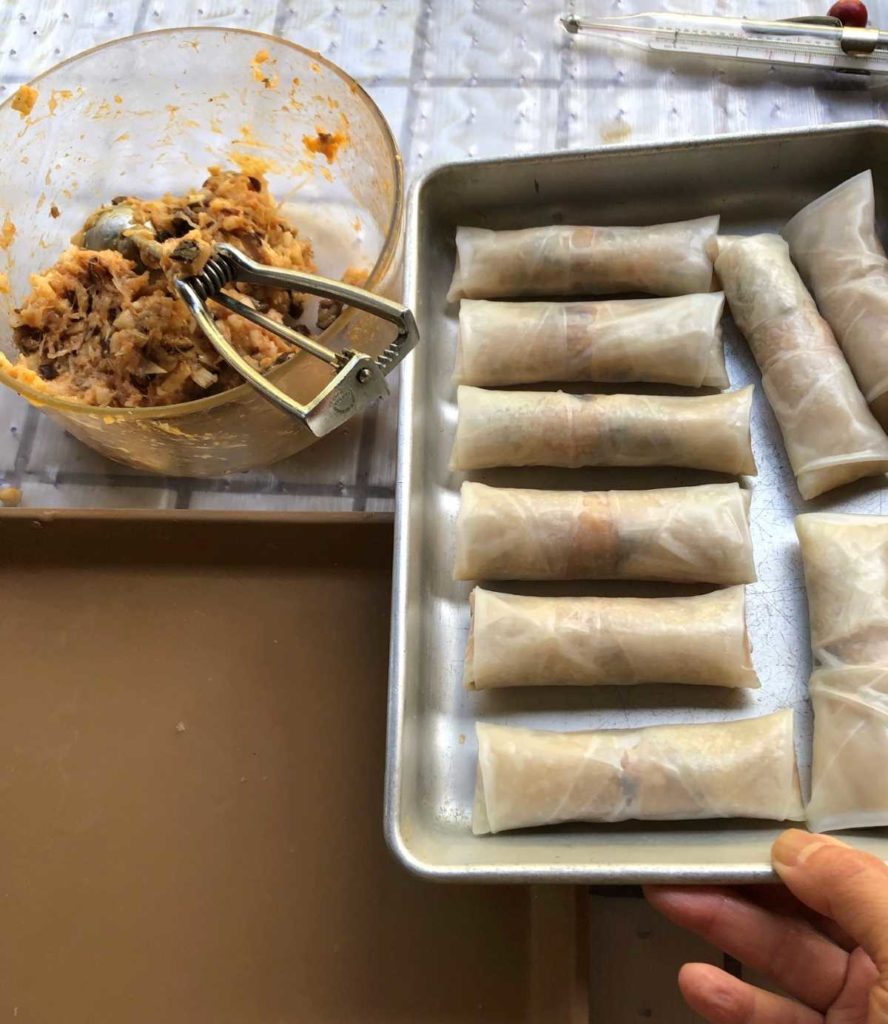
Because the filling is raw, it will be naturally wet and a bit messy to deal with. My mom uses an ice cream scoop to portion and place the filling. Then we use finger tips to neaten and shape the filling into a log.
Another way to deal with moisture is to very quickly wet the rice paper. Rice paper for frying chả giò need little water to soften. If the package has suggestions to add vinegar to the dipping water, try it out. It somewhat helps in the frying process to help crisp and brown.
What to fry Cha Gio In
Lots of oil. A wok or Dutch oven works well. Frying in a wok is great because you use less oil. As for the oil, a neutral oil such as vegetable oil, canola oil, or peanut oil will do. The oil may get yucky midway through frying a big batch so you may have to filter it. This is project cooking but the frying is not overly dramatic, if all goes well.
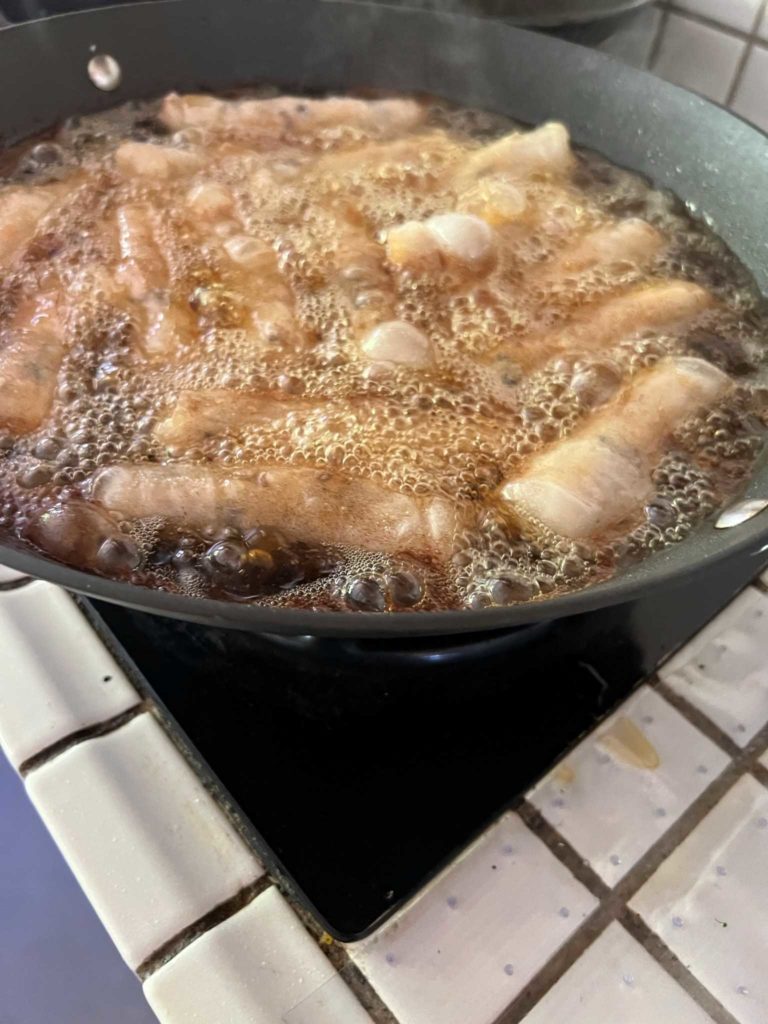
Be Ready for Cha Gio Triage
Because we were fooling around and playing roulette, something went wrong. One of the brands of rice paper was a total bust. The rolls busted open in the hot oil. Mom and I were so disappointed because we're always hopeful as soon as we drop a raw roll into the oil. Sigh. But, as soon as we noticed it was a pattern, she pulled the broken rolls from the oil. We let them cool until I could cut open the rolls, remove the filling, and re-roll them in new, more reliable rice paper.
Mom and I joked that despite the brand of rice paper promising that they were "100% OK" they were so NOT okay. I should have known. In Vietnamese, the brand promised to be especially good for fried and unfried rolls. Dumb me.
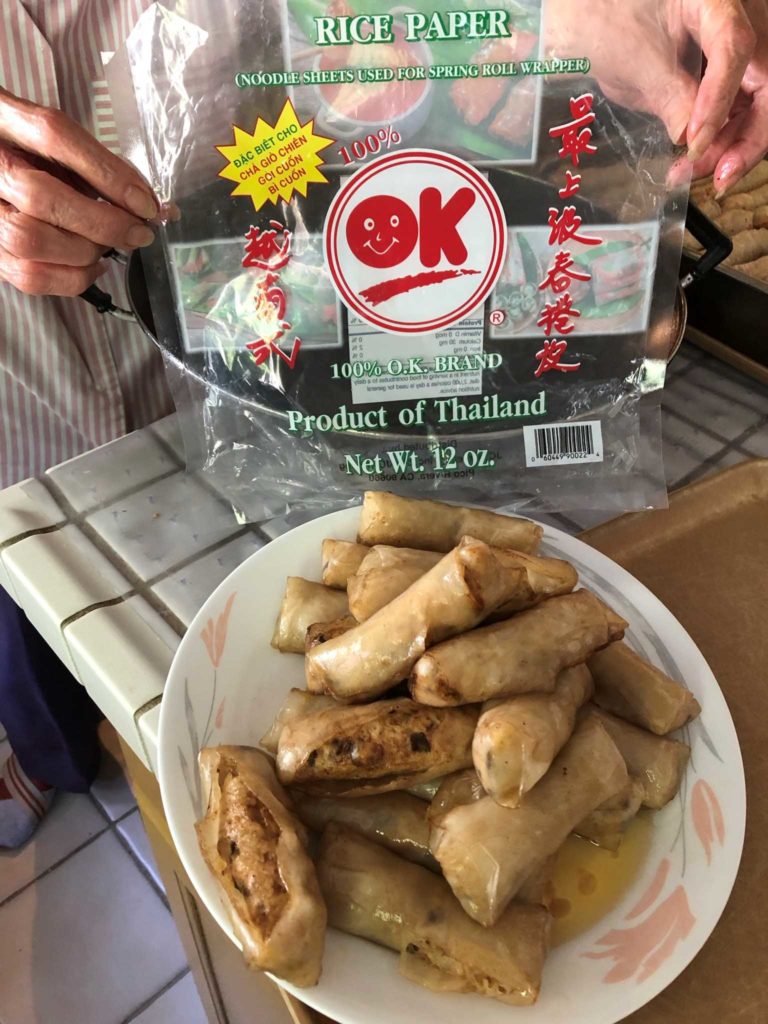
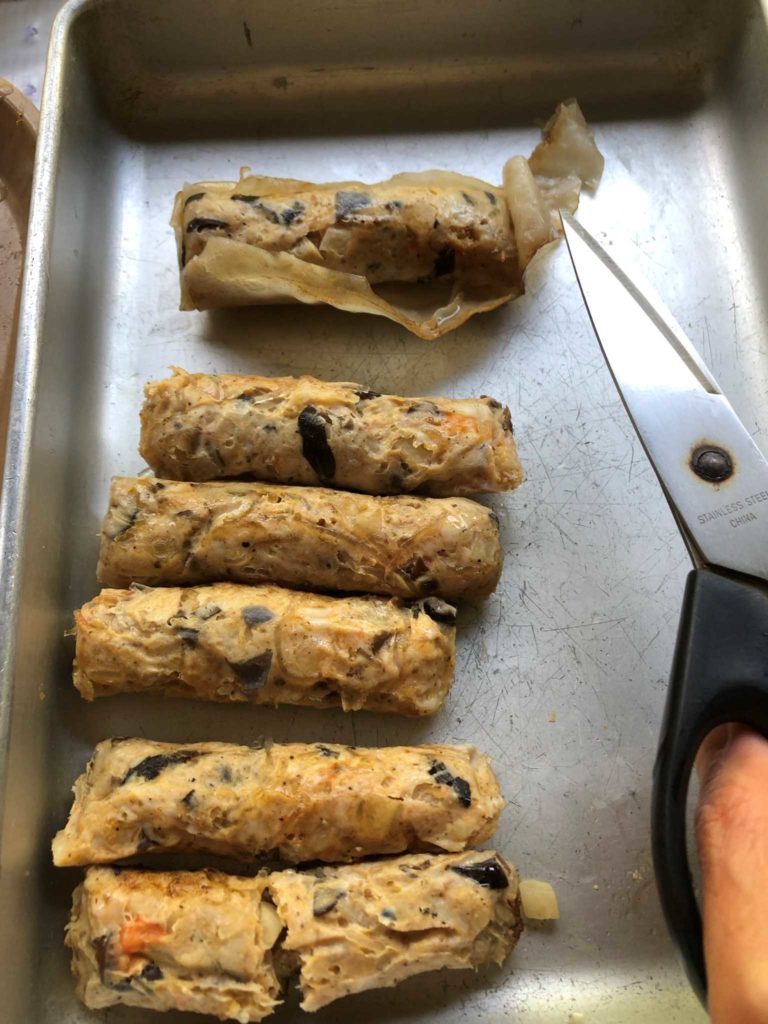
Cha Gio Double Fry and Storage
I've fried cha gio in single batches for 5 to 10 minutes at a moderate-low (325F) oil temperature, but when we're making 100 rolls, we use a double fry approach. My mom loads up the pan with rolls so they take a while to fry and the oil temperature goes down quite a lot after the rolls are added. Regardless of your approach, you want to fry the rolls until they are opaque white all over with some blond and brown touches.
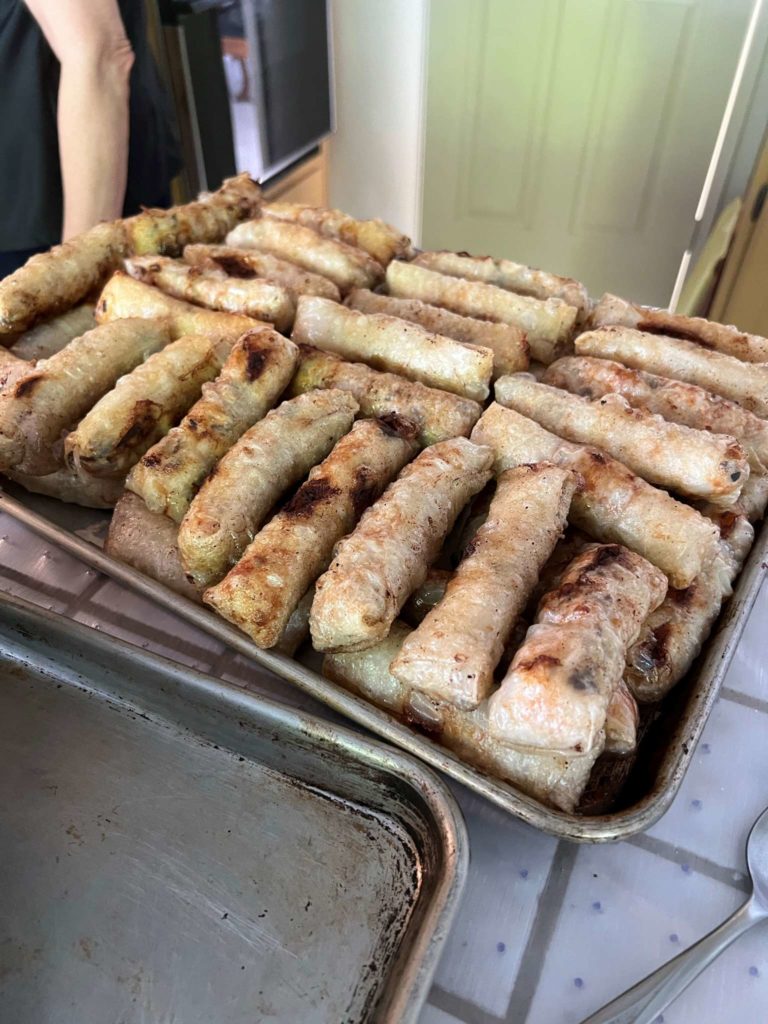
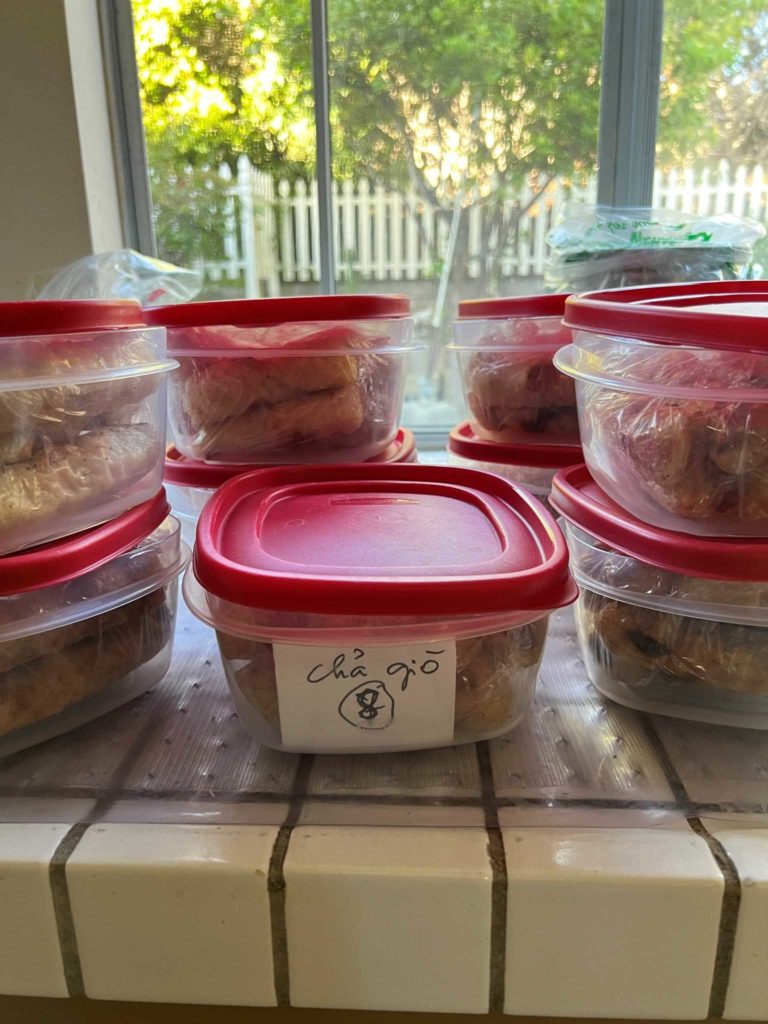
You can hold the first/single fry rolls at room temperature for a couple of hours, or refrigerate them for a few days. Or, freeze them for months! The rolls soften quickly to a chewiness once they're out of the oil. That's why you want to refry them to serve.
To refry -- I'm talking the second frying -- use an oil temperature of 350 to 375F. Bring the rolls back to room temperature (my dare devil mom has put them straight from teh freezer in oil). Pu the rolls a wok, pot, or deep skillet, add oil to cover and heat over medium meat. The rolls will warm up as the oil heats. Let them sizzle and fry for a few minutes until they are crisp and brown. Frying time depends on how cold the rolls are and how dark you need them to be. Don't they soak up a bunch of oil? Unless the rolls bust, they're not oil suckers. Rice paper makes a tight seal. Of course, drain the fried rolls on a rack after frying.
My mom's family-size batch is roughly 100 rolls. As the cooks' reward, we eat a few that day but most of them are frozen for a future treat.
So, What is the Best Rice Paper for Cha Gio?
This is an ever green question. On our recent chả giò adventures, the 3 brands photographed earlier in this post stood out. They fried up with few mishaps (no exploding rolls!) and held up to freezing and re-frying well. On a recent batch, we only used the Three Ladies Brand (Ba Co Gai) frying rice paper, and they worked fine. That brand tends to be more widely distributed than the others, so you may find it at Viet markets and online such as here. But, given the supply chain issues these days, you may find other brands when you're shopping. Try them out and do share your experience and tips with us all. Rice paper for frying can be on the brittle side. If you're strategic, you can roll with a tiny tear. But if it's a big tear, I throw the paper away. Mom likes to see if she can patch a bad rice paper but I'm not a risk taker like she is.
Chả giò is project cooking. It's fun with a buddy. It's great bonding time too. And, at the end of the line, you have a scrumptious Viet dish to share and enjoy.

















Steven McDowall says
I love these imperial rolls -- used to live in Minneapolis/St. Paul where you could get real nice ones just about anywhere. Now in North Carolina, no where can I find the real things. So I need to make my own. Great tips -- but do you have a link to a full recipe somewhere including the wetting technique and rolling etc? And your favorite nuoc Cham dipping sauce? And how to serve? I was in a Vietnamese restaurant in San Fran (Slanted Door) and they served them with mint leaves and something else ,, man they were great!
Andrea Nguyen says
Hi Stephen -- I have a full blown recipe in my first book, Into the Vietnamese Kitchen. Your local library likely has a copy! Hope you make your own soon.
Erica says
Thanks for the excellent instructions. I have all of your cookbooks - I am about to look up a recipe for the filling. Pray for our sweet Earth On this and every day.
Andrea Nguyen says
Thank you, Erica!
Alison Couldrey says
Such a great post with excellent tips, I love chả giò so much but have never had much success when making them but I’ll definitely try again after reading this, I’ll try keeping moisture down and pay more attention to the rice content of the wrapping ‘paper’ , thank you and your Mum for the inspiration and education
Andrea Nguyen says
Our pleasure, Alison!
Lisa says
Thank you for this educating article! My husband & I moved a few years ago from the Bay Area to Baltimore MD. It’s been hard to find Imperial Rolls like we’re used to on the west coast here; most places use wonton wrappers and sometimes they’re straight up Chinese spring rolls (from a Viet restaurant), not filled with cha gio ingredients. And no one seems to call them Imperial Rolls so I’m glad to know their Vietnamese name. I adore them so much I may have to try making them now.🙂
Andrea Nguyen says
It's frustrating, Lisa. Few Viet restaurants make the old school ones these days. So we have to take matters into our own hands!
Nghiem says
Ahhh, the definitive word on rice paper wrapping for cha gio. I do understand the vietnamese restaurants and families that use wheat based paper. But the classic will always be rice paper. Thank you Andrea.
Andrea Nguyen says
Truth, Nghiem. Banh trang for the cha gio win! It's the Nguyen-ing way to go. 😀